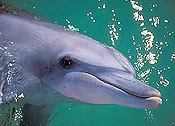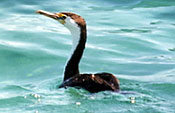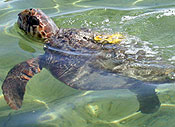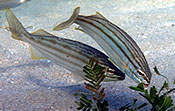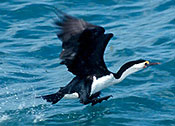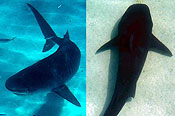
Research Projects

Click the Image Below to go to an Individual Research Page
Tiger Sharks
Indo-Pacific Bottlenose Dolphins
Sea Snakes
Rays and Small Sharks
Cormorants
Dugongs
Green and Loggerhead Turtles
Fish Communities
Seagrass
Context Dependence of Predator Risk Effects
Escape Tactics and Predator Risk Effects
Indirect Effects of Tiger Sharks
Diving behavior
Research Projects
Welcome to the Shark Bay Ecosystem Research Project's Research Home Page. Below you will find links to individual pages for each of our reasearch projects. You will find lists of scientific publications associated with each project on these pages. For a complete list of SBERP's publications scroll to the bottom of the page.
Community Dynamics: The Importance of Behavior
Our work in Shark Bay focuses on two major issues. First, we are interested in elucidating the dynamics of a pristine ecosystem. Much of our initial investigations have focused on determining why key species - tiger sharks, dolphins, dugongs, sea turtles, and others - choose to spend time in particularly habitats. As you will see in our individual species pages, for many of these animals they have to make trade-offs between getting enough food to eat and avoiding becoming a meal for a tiger shark because the habitats with the most food usually are the most dangerous. Our work on individual species led us to the broader question of just what is the ecological role of tiger sharks in such a pristine ecosystem. As part of this work, we are interested in how sharks might influence their prey not only through direct predation (i.e. consuming prey) but also through inducing costly anti-predator behavior ("risk effects"). We have found that the risk of tiger shark predation is a major structuring force in Shark Bay even though they rarely kill individuals of some potential prey species. In fact, the risk effects of tiger sharks probably exceed those of direct predation for many species. Our past and ongoing work focused on the effects of tiger sharks on the habitat use and diving behavior of many prey species including dolphins, dugongs, pied cormorants, green and loggerhead sea turtles, and sea snakes. Now, we are trying to determine how these effects on prey might be transmitted to other species in the ecosystem including small fishes and seagrasses (see our Indirect Effects of Tiger Sharks page), how tiger sharks and their prey might respond differently in various regions of Shark Bay that have slightly different configurations of habitats (see our Context Dependence of Predator Effects page), and how differences among prey species in their escape behavior might result in differing responses to tiger shark predation risk (see our Escape Tactics page).
Trophic Structure of a Pristine Ecosystem
Unlike many mangroves, those in Shark Bay do not have extensive root systems that drape into the water to provide abundant habitat for small fish and invertebrates. In the few places where roots do create hiding spots from predators, small fish pack in. Also, the mangroves throughout much of Shark Bay are in saltwater tidal creeks rather than at the mouth of a river. In this video you can see yellowtail trumpeters, small striped trumpeters, bream, and several other species.
Recently, SBERP has begun investigating the trophic structure of the bay using a variety of techniques including stable isotope and fatty acid analysis. By investigating the ratio of heavy and light nitrogen isotopes, we can get insights into how high in the food web a species is feeding. We can use carbon isotopes to determine what food web a species tends to feed in (for example in a seagrass-based, plankton-based, or mangrove-based food web; check out the turtle and ray pages above for more information on some of these studies). With samples from a variety of organisms in the bay -from primary producers to tiger sharks and many species in between - we are trying to trace the flow of energy from the base of the food web to the top. To pursue these we have branched out from the seagrass beds to other habitats like the sandy habitats along the coasts and the mangrove-lined creeks and shores that are found in several areas of the bay.
The ultimate goal of all our research is to gain a functional understanding of a pristine seagrass community to be able to make predictions about how Shark Bay and other systems are likely to respond to human-induced changes to coastal oceans including climate change and overfishing of top predators (like tiger sharks). Also, we hope that our research will provide an important baseline for the restoration of already impacted seagrass ecosystems around the world and provide lessons for the types of species and interactions that are important to conserve and restore (see our "Conservation Lessons" page).
Publications of the Shark Bay Ecosystem Research Project
- Heithaus, M. R., J. J. Vaudo, S. Kreicker, C. A. Layman, M. Krutzen, D. A. Burkholder, K. Gastrich, C. Bessey, R. Sarabia, K. Cameron, A. Wirsing, J. A. Thomson, and M. M. Dunphy-Daly. 2013. Apparent resource partitioning and trophic structure of large-bodied marine predators in a relatively pristine seagrass ecosystem. Marine Ecology Progress Series in press
- Heithaus, M. R. Predators, prey, and ecological roles of sea turtles. 2013. In: Wyneken, J. and J. A. Musick (eds) Biology of Sea Turtles, Volume III. CRC Press.
- Burkholder, D. A., M. R. Heithaus, and J. A. Fourqurean. 2013. Spatial pattern in seagrass stoichiometry indicates both N-limited and P-limited regions of an iconic P-limited subtropical bay. Marine Ecology Progress Series.
- Heithaus, M. R., A. J. Wirsing, and L. M. Dill. 2012. The ecological importance of intact top predator populations: a synthesis of 15 years of research in a seagrass ecosystem. Marine and Freshwater Research 63: 1039-1050.
- Price, R.M., G. Skrzypek, P.F. Grierson, P.K. Swart, and J.W. Fourqurean. 2012. The use of stable isotopes of oxygen and hydrogen in identifying water exchange of in two hypersaline estuaries with different hydrologic regimes. Marine and Freshwater Research 63: 952-966.
- Frankovich, T.A., J. Barr, D. Morrison and J.W. Fourqurean. 2012. Differential importance of water quality parameters and temporal patterns of submerged aquatic vegetation (SAV) cover in adjacent sub-estuaries distinguished by alternate regimes of phytoplankton and SAV dominance. Marine and Freshwater Research 63: 1105-1114.
- Fourqurean, J.W., G.A. Kendrick, L.S. Collins, R.M. Chambers and M.A. Vanderklift. 2012. Carbon and nutrient storage in subtropical seagrass meadows: examples from Florida Bay and Shark Bay. Marine and Freshwater Research 63: 967-983.
- Olson, E. L., A. K. Salomon, A. J. Wirsing and M. R. Heithaus. 2012. Large-scale movement patterns of male loggerhead sea turtles (Caretta caretta) in Shark Bay, Australia. Marine and Freshwater Research 63: 1108-1116.
- Cawley, K. M., Y. Ding, J. Fourqurean, and R. Jaffé. 2012. Characterizing the sources and fate of dissolved organic matter in Shark Bay, Australia: A preliminary study using optical properties and stable carbon isotopes. Marine and Freshwater Research 63: 1098-1107.
- Wirsing, A. J and, M. R. Heithaus. 2012. Behavioral transition probabilities in dugongs change with habitat and predator presence: implications for sirenian conservation. Marine and Freshwater Research 63:1069-1076.
- Burkholder, D. A., M. R. Heithaus, and J. A. Fourqurean. 2012. Feeding preferences of herbivores in a relatively pristine subtropical seagrass ecosystem. Marine and Freshwater Research 63: 1051-1058.
- Belicka, L. L., D. Burkholder, J. W. Fourqurean, M.R. Heithaus, S. A. Macko and R. Jaffé. 2012. Stable isotope and fatty acid biomarkers of seagrass, epiphytic, and algal organic matter to consumers in a nearly pristine seagrass ecosystem. Marine and Freshwater Research 63: 1085-1097.
- Kendrick, G. A., J. W. Fourqurean, M. Fraser, M. R. Heithaus, G. Jackson, K. Friedman, and D. Hallac. 2012. Science behind management of Shark Bay and Florida Bay, two P-limited subtropical systems with different climatology and human pressures. Marine and Freshwater Research 63: 941-951.
- Vaudo, J. J. and M. R. Heithaus. 2012. Seasonal and diel variation in the use of nearshore sandflats by five species of rays in a near pristine ecosystem. Marine and Freshwater Research 63:1077-1084.
- Thomson, J. A., M. R. Heithaus, and L. M. Dill. 2011. Informing the interpretation of dive profiles using animal-borne video: a marine turtle case study. Journal of Experimental Marine Biology and Ecology 410: 12-20.
- Burkholder, D., M. R. Heithaus, J. Thomson, and J. A Fourqurean. 2011. Diversity in trophic interactions of green sea turtles (Chelonia mydas) on a relatively pristine coastal foraging ground. Marine Ecology Progress Series 439:277-293.
- Thomson, J. A., D. A. Burkholder, A. B. Cooper, M. R. Heithaus, and L. M. Dill. 2012. Heterogeneous patterns of availability for detection during visual surveys: spatiotemporal variation in sea turtle dive-surfacing behaviour on a feeding ground. Methods in Ecology and Evolution 3: 378-387.
- Heithaus, M. R. and J. J. Vaudo. 2012. Predator-prey interactions. Pages 505-546 In: J. C. Carrier, M. R. Heithaus, and J. A. Musick (eds). The biology of sharks and their relatives, second edition. CRC Press.
- Wirsing, A. J. and W. J. Ripple. 2011. A comparison of shark and wolf research reveals similar behavioral responses by prey. Frontiers in Ecology and the Environment 9: 335-341.
- Vaudo, J. J. and M. R. Heithaus. 2011. High trophic level consumers: elasmobranchs. Pages 203-225. In E. Wolanski and D. McLusky (eds) Tretise on estuarine and coastal science. Volume 6: Trophic relationships of coastal and estuarine ecosystems. Elsivier, Inc.
- Heithaus, E. R., P. A. Heithaus, M. R. Heithaus, D. Burkholder, and C. A. Layman. 2011. Trophic dynamics in a relatively pristine subtropical fringing mangrove community. Marine Ecology Progress Series 428: 49-61.
- Wirsing, A. J., M. R. Heithaus, and L. M. Dill. 2011. Predator-induced modifications to diving behavior very with foraging mode. Oikos 120: 1005-1012.
- Vaudo, J. J. and M. R. Heithaus. 2011. Dietary niche overlap in a nearshore elasmobranch mesopredator community. Marine Ecology Progress Series 425: 247-260.
- Matich, P., M. R. Heithaus, and C. A. Layman. 2011. Contrasting patterns of individual specialization and trophic coupling in two marine apex predators. Journal of Animal Ecology 80: 294-305.
- Feretti, F. B. Worm, G. L. Britten, M. R. Heithaus, H. K. Lotze. 2010. Patterns and ecosystem consequences of shark declines in the ocean. Ecology Letters 13: 1055-1071.
- Matich, P., M. R. Heithaus, and C. A. Layman. 2010. Size-based inter-tissue comparisons of stable carbon and notrogen isotope signatures of bull and tiger sharks. Canadian Journal of Fisheries and Aquatic Sciences 67: 877-885.
- Wirsing, A. J., K. A. Cameron, and M. R. Heithaus. 2010. Spatial responses to predators vary with prey escape mode. Animal Behaviour 79: 531-537.
- Dunphy-Daly, M. M., M. R. Heithaus, A. J. Wirsing, J. S. F. Maradon, and D. A. Burkholder. 2010. Predation risk influences the diving behavior of a marine mesopredator. Open Ecology Journal 3: 8-15
- Vaudo, J. J. and M. R. Heithaus. 2009. Spatiotemporal variability in a sandflat elasmobranch fauna in Shark Bay, Australia. Marine Biology 156: 2579-2590.
- Wirsing, A. J. and M. R. Heithaus. 2009. Olive-headed sea snakes (Disteria major) shift seagrass microhabitats to avoid shark predation. Marine Ecology Progress Series 387:287-293.
- Heithaus, M. R., A. Frid, J. Vaudo, B. Worm, and A. J. Wirsing. 2010. Unraveling the ecological importance of elasmobranchs. In: J. C. Carrier, M. R. Heithaus, and J. A. Musick (eds). Sharks and their relatives II: Biodiversity, adaptive physiology, and conservation. CRC Press. pp611-637.
- Heithaus, M. R., A. J. Wirsing, D. Burkholder, J. Thomson, and L. M. Dill. 2009. Towards a predictive framework for predator risk effects: the interaction of landscape features and prey escape tactics. Journal of Animal Ecology 78: 556-562.
- Thomson, J. A., D. Burkholder, M. R. Heithaus, and L. M. Dill. 2009. Validation of a rapid visual assesment technique for categorizing the body condition of green sea turtles. Copeia 2009: 251-255.
- Heithaus, M. R., A. Frid, A. J. Wirsing, and B. Worm. 2008. Predicting ecological consequences of marine top predator declines. Trends in Ecology and Evolution 23: 202-210.
- Wirsing, A. J., M. R. Heithaus, A. Frid, and L. M. Dill. 2008. Seascapes of fear: methods for evaluation sublethal predator effects experienced and generated by marine ammals. Marine Mammal Science 24: 1-15.
- Kerford, M. A., A. J. Wirsing, M. R. Heithaus, and L. M. Dill. 2008. Danger on the rise: habitat use by bar-bellied sea snakes in Shark Bay, Western Australia. Marine Ecology Progress Series 358: 289-294.
- Wirsing, A. J., R. Abernathy, and M. R. Heithaus . 2008. Speed and maneuverability of adult loggerhead turtles (Caretta caretta) under simulated predatory attack: do the sexes differ? Journal of Herpetology 42: 411-413.
- Heithaus, M. R., A. J. Wirsing, J. Thomson, and D. Burkholder. 2008. A reveiew of lethal and non-lethal effects of predators on adult marine turtles. Journal of Experimental Marine Biology and Ecology 356: 43-51.
- Heithaus, M. R. A. J. Wirsing, A. Frid, and L. M. Dill. 2007. Species interactions and marine conservation: lessons from an undisturbed ecosystem. Israel Journal of Ecology and Evolution 53: 355-370.
- Wirsing, A. J., M. R. Heithaus, and L. M. Dill. 2007. Can you dig it? Use of excavation, a risky foraging tactic, by dugongs is sensitive to predation danger. Animal Behavior 74: 1085-1091.
- Wirsing, A. J., M. R. Heithaus, and L. M. Dill. 2007. Fear factor: Do dugogns (Dugong dugon) trade food for safety from tiger sharks (Galeocerdo cuvier)? Oecologia 153: 1031-1040.
- Heithaus, M. R., A. Fird, A. J. Wirsing, L. M. Dill, J. Fourqurean, D. Burkholder, J. Thomson, and L. Bejder. 2007. State-dependent risk-taking by green sea turtles mediates top-down effects of tiger shark intimidation in a marine ecosystem. Journal of Animal Ecology 76: 837-844.
- Wirsing, A. J., M. R. Heithaus, and L. M. Dill. 2007. Can measures of prey availability improve our ability to predict the abundance of large marine predators? Oecologia 153:563-568.
- Rova, A., G. Mori, and L. M. Dill. 2007. One fish, two fish, butterfish, trumpeter: recognizing fish in underwater video. IAPR Conference on Machine Vision Applications, 2007.
- Wirsing, A. J., M. R. Heithaus, and L. M. Dill. 2007. Living on the edge: dugongs prefer foraging microhabitats that allow escape rather than avoidance of predators. Animal Behaviour 74: 93-101.
- Heithaus, M. R., A. J. Wirsing, and L. M. Dill. 2007. Long-term movements of tiger sharks satellite-tagged in Shark Bay, Western Australia. Marine Biology 151: 1455-1461.
- Wirsing, A. J., M. R. Heithaus, and L. M. Dill. 2006. Tiger shark (Galeocerdo cuvier) abundance and growth rates in a subtropical embayment: evidence from seven years of standardized fishing effort. Marine Biology 4: 961-968.
- Heithaus, M. R., I. M. Hamilton, A. J. Wirsing, and L. M. Dill. 2006. Validation of a randomization procedure to assess animal habitat preferences: microhabitat use of tiger sharks in a seagrass ecosystem. Journal of Animal Ecology 75: 666-676.
- Heithaus, M. R. and L. M. Dill. 2006. Does tiger shark predation risk influence foraging habitat use by bottlenose dolphins at multiple spatial scales? Oikos 114: 257-264.
- Semeniuk, C.A.D. and L.M. Dill. 2006. Anti-predator benefits of mixed species groups of cowtail stingrays (Pastinachus sephen) and whiprays (Himantura uranak) at rest. Ethology 112 33-43.
- Heithaus, M. R., A. Frid, A. Wirsing, L. Bejder, and L. M. Dill. 2005. The biology of green and loggerhead turtles under risk from tiger sharks at a foraging ground. Marine Ecology Progress Series 288: 285-294.
- Heithaus, M. R. 2005. Habitat use and group size of pied cormorants (Phalacrocorax varius) in a sea grass ecosystem: possible effects of food abundance and predation risk. Marine Biology 147: 27-35.
- Semeniuk, C.A.D. and L.M. Dill. 2005. Cost/benefit analysis of group and solitary resting in the cowtail stingray, Pastinachus sephen. Behavioral Ecology 16: 417-426.
- Heithaus, M. R. 2004. Fish communities of seagrass meadows and associated habitats in Shark Bay, Western Australia. Bulletin of Marine Science 75: 79-99.
- Dill, LM, Dill, ES, and Charles, D. 2003. Feeding preferences of the Monkey Mia dolphins: results from a simultaneous choice protocol. Marine Mammal Science 19: 650-660.
- Heithaus, M. R. and A. Frid. 2003. Optimal diving under the risk of predation. Journal of Theoretical Biology 2233: 79-93.
- Dill, L. M., M. R. Heithaus, and C. J. Walters. 2003. Behaviorally-mediated indirect species interactions in marine communities and their conservation implications. Ecology 84: 1151-11567.
- Heithaus, M. R. J. M. McLash, A. Frid, L. M. Dill, and G. J. Marshall. 2002. Novel insights into the behavior of sea turtles from animal-borne cameras. Journal of the Marine Biological Association UK: 1049-1050.
- Heithaus, M. R., L. M. Dill, G. J. Marshall, and B. Buhleier. 2002. Habitat use and foraging behavior of tiger sharks (Galeocerdo cuvier) in a sea grass ecosystem. Marine Biology 140: 237-248.
- Heithaus, M. R., A. Frid, and L. M. Dill . 2002. Shark-inflicted injury frequencies, escape ability, and habitat use of green and loggerhead turtles. Marine Biology 140: 229-236.
- Heithaus, M. R. and L. M. Dill. 2002. Food availability and tiger shark predation risk influence bottlenose dolphin habitat use. Ecology 83: 480-491.
- Heithaus, M. R. and L. M. Dill. 2002. Feeding Tactics and Strategies. Pp 412-422 in Perrin, W. F., B. Wursig, and H. G. M. Thewissen (eds.). The Encyclopedia of Marine Mammals. Academic Press, NY.
- Heithaus, M. R. 2001. Habitat selection by predators and prey in communities with asymmetrical intraguild predation. Oikos 92: 542-554.
- Heithaus, M. R. 2001. Shark attacks on bottlenose dolphins (Tursiops aduncus) in Shark Bay, Western Australia: attack rate, bite scar frequencies, and attack seasonality. Marine Mammal Science 17: 526-539.
- Heithaus, M. R. 2001. The biology of tiger sharks (Galeocerdo cuvier) in Shark Bay, Western Australia: sex ratio, size distribution, diet, and seasonal changes in catch rates. Environmental Biology of Fishes 61: 25-36.
- Heithaus, M. R., G. J. Marshall, B. M. Buhleier, and L. M. Dill. 2001. Employing Crittercam to study habitat use and behavior of large sharks. Marine Ecology Progress Series 209: 307-310.
- Heithaus, M. R. 2001. Predator-prey and competitive interactions between sharks (order Selachii) and dolphins (suborder Odontoceti): a review. Journal of Zoology (London) 253: 53-68.
All photographs copyrighted; Images may be used for educational purposes. For use in other forms contact Mike Heithaus

